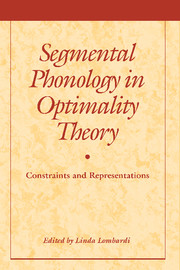Book contents
- Frontmatter
- Contents
- List of Contributors
- Introduction
- I The Content of Representations
- 1 Why Place and Voice Are Different: Constraint-Specific Alternations in Optimality Theory
- 2 Constraints and Representation in Subsegmental Phonology
- 3 Phonological Contrast and Articulatory Effort
- 4 Markedness, Segment Realization, and Locality in Spreading
- II The Content of Constraints
- III The Structure of the Grammar: Approaches to Opacity
- Index
3 - Phonological Contrast and Articulatory Effort
Published online by Cambridge University Press: 05 July 2014
- Frontmatter
- Contents
- List of Contributors
- Introduction
- I The Content of Representations
- 1 Why Place and Voice Are Different: Constraint-Specific Alternations in Optimality Theory
- 2 Constraints and Representation in Subsegmental Phonology
- 3 Phonological Contrast and Articulatory Effort
- 4 Markedness, Segment Realization, and Locality in Spreading
- II The Content of Constraints
- III The Structure of the Grammar: Approaches to Opacity
- Index
Summary
Phonological theory has long been guided by the assumption that the representational elements consist of a limited inventory of distinctive features. Ostensibly, this assumption is motivated by the limited range of contrasts observed in sound systems. For example, segments are standardly categorized, for purposes of phonological analysis, as either [+nasal] or [-nasal]; further phonetic details (e.g., the precise area of the velo-pharyngeal port) are excluded from the representational inventory. The theory thus rules out unattested sound systems in which, for example, unnasalized, slightly nasalized, moderately nasalized, and heavily nasalized vowels all behave as separate phonemes.
In this chapter, I will argue against this representational assumption. In Section 1, I demonstrate that the assumption is superfluous to an adequate treatment of phonological contrast. Rather, within the framework of Optimality Theory (Prince and Smolensky 1993), the contrastive status of a featural distinction [F] within a sound system falls out from the ranking of the corresponding input-output (IO) faithfulness constraint. Under the further assumption that, for some [F], the universal constraint set lacks a corresponding IO faithfulness constraint, it follows that [F] cannot have contrastive status under any constraint ranking. It is thus possible to include the full range of phonetic detail in phonological representations, without thereby predicting spurious contrasts.
- Type
- Chapter
- Information
- Segmental Phonology in Optimality TheoryConstraints and Representations, pp. 79 - 117Publisher: Cambridge University PressPrint publication year: 2001
- 5
- Cited by

